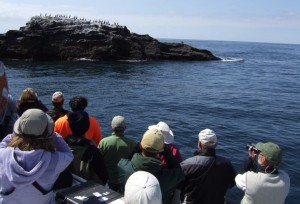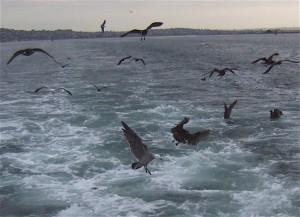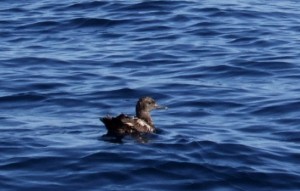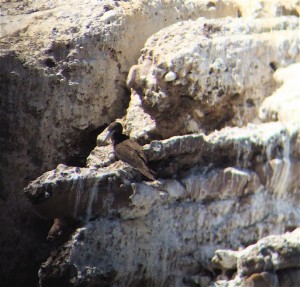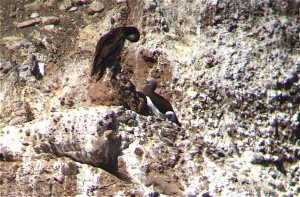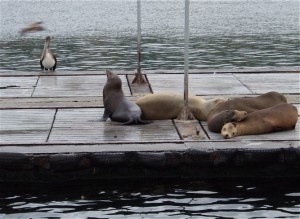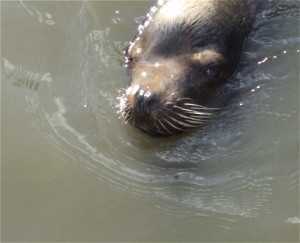Hey, do you notice anything different? We've changed from blogger to word press for blogging software. All the are there and hopefully in the next few weeks as I get used to this we'll be able to organize things so you can find answers to bird questions easier. If you think of a category that would be useful, let me know and I'll talk to my trusty web master, Non Birding Bill.
So, I'm going to test out this bad boy with a blog entry from the San Diego Bird Festival. One of the field trips I was super excited about was a pelagic trip to the Cornado Islands to watch seabirds. I really enjoy any bird trip by boat--a day in a boat is automatically an adventure. I must say that this is was one of the smoothest pelagic trips I've ever been on. The seas were calm and the weather started chilly, but I was down to a t-shirt by the afternoon. I don't think anyone got remotely ill and we would have been fine without any Bonine.
It was a different set of gulls following the chum off the back of the boat on this trip compared to what we saw on the pelagic trip in Florida. One of my favorites was that dark gull with the white head--a Heerman's gull. Actually, the others are Heerman's too, just immature birds.
There were several birds I was hoping to get. Some I had seen before like the sooty shearwater above, but there were several new birds for me including Xantus's murrelet, black-vented shearwater, rhinoceros auklet and Cassin's auklet. You might think that getting these new birds are pretty darned easy out on the open water, but looking for dark birds about the size of a nerf football, is a bit tricky. I've always chuckled about birders say when pointing out birds:
"It's there in that tree," they shout while point to a woods.
Well, it's not much better on the ocean. You can try the clock, "The murrelet is at about 1 o'clock, about 200 meters out."
I'm not very good with meters and yards, I struggled. But fortunately, we had some excellent guides on the boat and the captain even made sure to pass as smoothly as possible so as not to spook birds.
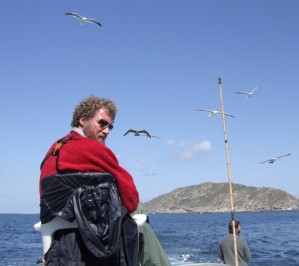 Speaking of guides, did I mention that Steve Howell was one of our guides? Steve has been part of some the largest and most hardcore books out there including illustrations for Pyle books and he co-authored A Guide to the Birds of Mexico and Northern Central America--a hefty book that rivals Sibley in weight and is considered a dangerous weapon in some states.
Speaking of guides, did I mention that Steve Howell was one of our guides? Steve has been part of some the largest and most hardcore books out there including illustrations for Pyle books and he co-authored A Guide to the Birds of Mexico and Northern Central America--a hefty book that rivals Sibley in weight and is considered a dangerous weapon in some states.
The most exciting new bird for me on the trip was a brown booby. I have been waiting over thirty years to see one of these things, ever since I read about them as a kid and discovered there birds with dirty names. Plus, they are just a cool looking bird anyway.
I can't really bring a scope on a boat trip, but I did try to get shots by hold my camera to my binoculars. They are not the best photos on the planet, but they make good souveniers for my lifer boobies.
We had some fun mammal action on the trip too, there were many sealions...
This one came right up to our boat just as we were docking. It apparently has some eye problems and gets a few handouts by many locals. It was swam up to the ship and when fish was not tossed to it immediately, went looking for more generous humans.
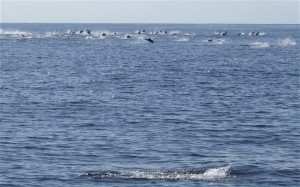 One of the craziest things we saw was a pod of dolphins on the move. There looked to be between 150 - 200 hundred, close the surface of the water. They were moving fast and jumping out of the water. The moved quickly and our boat followed them a bit. I don't know if they were migrating or what, but was amazing to see so many dolphins on the move. Other maring mammals observed included Risso's dolphin and gray whale.
One of the craziest things we saw was a pod of dolphins on the move. There looked to be between 150 - 200 hundred, close the surface of the water. They were moving fast and jumping out of the water. The moved quickly and our boat followed them a bit. I don't know if they were migrating or what, but was amazing to see so many dolphins on the move. Other maring mammals observed included Risso's dolphin and gray whale.
Okay, now let's see how this entry posts in the new blog.

